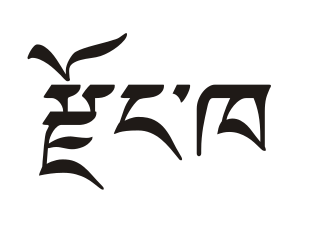
Dzongkha is a Sino-Tibetan language that is the official and national language of Bhutan. It is written using the Tibetan script.
The Mahakiranti or Maha-Kiranti languages are a proposed intermediate level of classification of the Sino-Tibetan languages, consisting of the Kiranti languages and neighbouring languages thought to be closely related to them. Researchers disagree on which languages belong in Mahakiranti, or even whether Mahakiranti is a valid group. The group was originally proposed by George van Driem, who retracted his proposal in 2004 after a field study in Bhutan.
Tshangla is a Sino-Tibetan language of the Bodish branch closely related to the Tibetic languages. Tshangla is primarily spoken in Eastern Bhutan and acts as a lingua franca in the region; it is also spoken in the adjoining Tawang tract in the Indian state of Arunachal Pradesh and the Pemako region of Tibet. Tshangla is the principal pre-Tibetan language of Bhutan.

George "Sjors" van Driem is a Dutch linguist associated with the University of Bern, where he was the chair of Historical Linguistics and directed the Linguistics Institute. He became professor emeritus in 2022.
The Himalayan Languages Project, launched in 1993, is a research collective based at Leiden University and comprising much of the world's authoritative research on the lesser-known and endangered languages of the Himalayas, in Nepal, China, Bhutan, and India. Its members regularly spend months or years at a time doing field research with native speakers. The Director of the Himalayan Languages Project is George van Driem; other top authorities include Mark Turin and Jeroen Wiedenhof. It recruits grad students to collect new field research on little-known languages as the topics for their Ph.D. dissertations.

There are two dozen languages of Bhutan, all members of the Tibeto-Burman language family except for Nepali, which is an Indo-Aryan language, and Bhutanese Sign Language. Dzongkha, the national language, is the only native language of Bhutan with a literary tradition, though Lepcha and Nepali are literary languages in other countries. Other non-Bhutanese minority languages are also spoken along Bhutan's borders and among the primarily Nepali-speaking Lhotshampa community in South and East Bhutan. Chöke is the language of the traditional literature and learning of the Buddhist monastics.
The Khengkha language, or Kheng, is an East Bodish language spoken by ~40,000 native speakers worldwide, in the Zhemgang, Trongsa, and Mongar districts of south–central Bhutan.
The Kiranti languages are a major family of Sino-Tibetan languages spoken in Nepal and India by the Kirati people.
The Sal languages, also known as Brahmaputran languages, are a branch of Tibeto-Burman languages spoken in northeast India, parts of Bangladesh, and Burma.
The Dhimalish languages, Dhimal and Toto, are a small group of Sino-Tibetan languages spoken in Nepal, Bhutan, and the Jalpaiguri division of West Bengal, India.
The Kurtöp language is an East Bodish language spoken in Kurtoe Gewog, Lhuntse District, Bhutan. In 1993, there were about 10,000 speakers of Kurtöp.

The Tibeto-Burman languages are the non-Sinitic members of the Sino-Tibetan language family, over 400 of which are spoken throughout the Southeast Asian Massif ("Zomia") as well as parts of East Asia and South Asia. Around 60 million people speak Tibeto-Burman languages. The name derives from the most widely spoken of these languages, Burmese and the Tibetic languages, which also have extensive literary traditions, dating from the 12th and 7th centuries respectively. Most of the other languages are spoken by much smaller communities, and many of them have not been described in detail.
Gongduk or Gongdu is an endangered Sino-Tibetan language spoken by about 1,000 people in a few inaccessible villages located near the Kuri Chhu river in the Gongdue Gewog of Mongar District in eastern Bhutan. The names of the villages are Bala, Dagsa, Damkhar, Pam, Pangthang, and Yangbari (Ethnologue).
The Dzala language, also called Dzalakha, Dzalamat, or Yangtsebikha, is an East Bodish language spoken in eastern Bhutan, in the Lhuntse and Trashiyangtse Districts.

ʼOle, also called ʼOlekha or Black Mountain Monpa, is possibly a Sino-Tibetan language spoken by about 1,000 people in the Black Mountains of Wangdue Phodrang and Trongsa Districts in western Bhutan. The term ʼOle refers to a clan of speakers.
The Chocha Ngacha language or Chochangachakha or Tsamang is a Southern Tibetic language spoken by about 20,000 people in the Kurichu Valley of Lhuntse and Mongar Districts in eastern Bhutan.
The Bumthang language ; also called "Bhumtam", "Bumtang(kha)", "Bumtanp", "Bumthapkha", and "Kebumtamp") is an East Bodish language spoken by about 20,000 people in Bumthang and surrounding districts of Bhutan. Van Driem (1993) describes Bumthang as the dominant language of central Bhutan.

The Takpa or Dakpa language, Dakpakha, known in India as Tawang Monpa, also known as Brami in Bhutan, is an East Bodish language spoken in the Tawang district of Arunachal Pradesh, and in northern Trashigang District in eastern Bhutan, mainly in Kyaleng, Phongmed Gewog, Dangpholeng and Lengkhar near Radi Gewog. Van Driem (2001) describes Takpa as the most divergent of Bhutan's East Bodish languages, though it shares many similarities with Bumthang. SIL reports that Takpa may be a dialect of the Brokpa language and that it been influenced by the Dzala language whereas Brokpa has not.
Mewahang (Meohang), or Newahang, is a Kiranti language spoken in Nepal. The eastern and western dialects are structurally distinct.








